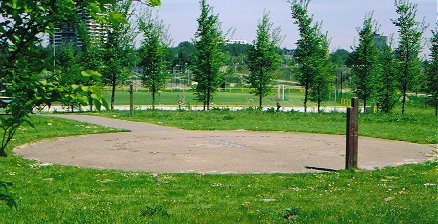
Analemmatic dials
Planet Trail, Hoekpolder Park, Rijswijk

In a small strip of green, which separates the south-eastern outskirts of Rijswijk from highway A4, a planet trail has been laid out. It ends at the Sun, on top of a small hill. Inside the sun disk a pretty analemmatic dial has been constructet. Its major axis measures 7 m (23 ft).
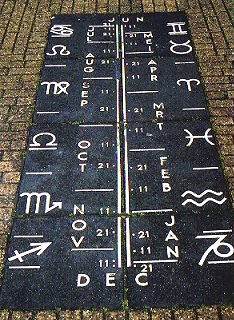 |
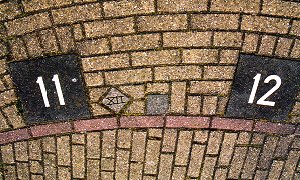 |
White plastic characters and symbols have been laid in the tiles that constitute the hour points and the date line. Even after eight years in the Dutch climate the texts are very well legible, thanks to the clear contrast.
The dial reads local time. Hour points are numbered from 4 to 20 hr; darker bricks in between as half-hour points. The number XII carved into a diamond-shaped brick indicates 12 o'clock Central European Time.
The date line has been divided in 1/3 month units, which made it easy to include the signs of the zodiac.
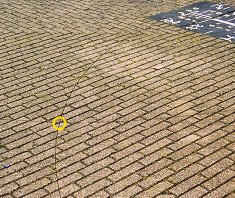 Note the Lambert circles for the winter and the summer solstice, which have been carved into the dial face. They intersect in the focal points of the ellipse (indicated by the yellow circle in the picture).
Note the Lambert circles for the winter and the summer solstice, which have been carved into the dial face. They intersect in the focal points of the ellipse (indicated by the yellow circle in the picture).
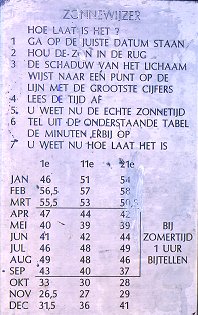 The post which is visible in the top picture holds the instructions for use. The table lists the combined corrections for the time zone and the equation of time, thus avoiding the +/- problem. Unfortunately, the designer has been overruled by the politicians, who extended daylight saving time by a month in 1996.
The post which is visible in the top picture holds the instructions for use. The table lists the combined corrections for the time zone and the equation of time, thus avoiding the +/- problem. Unfortunately, the designer has been overruled by the politicians, who extended daylight saving time by a month in 1996.
The half-minute resolution in the table doesn't make any sense. As if anyone would be able to read the dial at that accuracy! Moreover, it spoils the lay-out of the table. It would in fact be better to round the values to the nearest 5 min. That would make it also much easier to apply the corrections.
Location: 52.0° N, 4.3° E
Design: Jan Sant
Inauguration: September 1993
The planet trail
The planet trail is an initiative of the Rijswijk Amateur Astronomy Association (website in Dutch).
The smaller planets are each fixed to a post next to the sun disc. The earth is the only planet that has been immortalized with its companion.
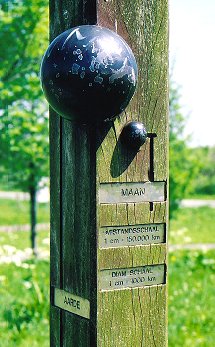 The patterns visible on the surface of earth and moon are no maps, but merely the consequence of weathering. This post also holds the scales of the planet trail. There are two separate scales, actually: 1 cm = 1000 km (1" to 1580 ml) for the size of the planets, and 1 cm = 150.000 km (1" to 237,000 ml) for the distance to the sun. They thus differ by a factor of 150.
The patterns visible on the surface of earth and moon are no maps, but merely the consequence of weathering. This post also holds the scales of the planet trail. There are two separate scales, actually: 1 cm = 1000 km (1" to 1580 ml) for the size of the planets, and 1 cm = 150.000 km (1" to 237,000 ml) for the distance to the sun. They thus differ by a factor of 150.
At that ratio, the moon should in fact be located inside the earth, as the distance between their centers should be 2.5 cm (1"). The solution chosen here is to make the distance between their surfaces equal to 2.5 cm.
If the size scale would be equal to the distance scale, the earth would be less than a millimeter in diameter, and one would need a magnifying glass to see the moon. Which reminds us once again how 'empty' our solar system actually is.
The size scale also applies to the size of the sun disc, which holds the dial. The sun's diameter is 1.4 million km (870,000 ml) and is represented here as 14 m (46 ft). If the distance scale was used, it would have been less than 10 cm (4").
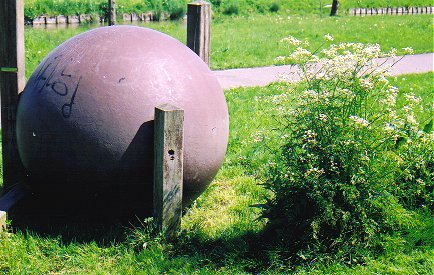
The 'fat boys' Jupiter (picture) and Saturn have been planted on solid ground. How the planets beyond these are looking, I didn't care to check.